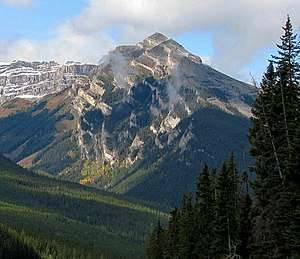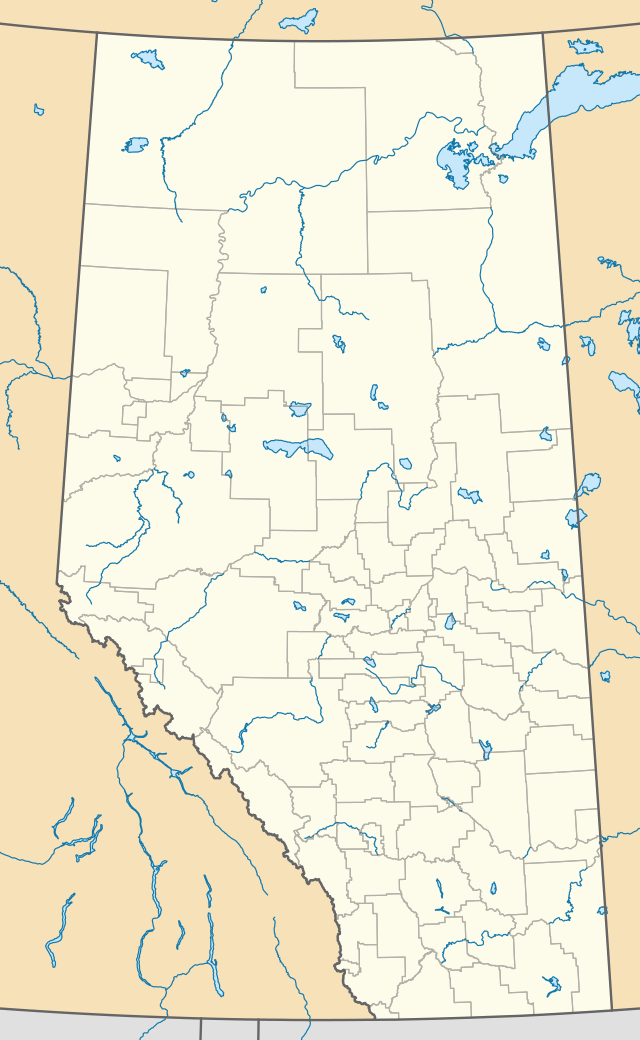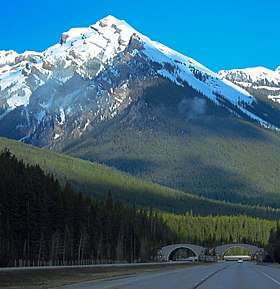Massive Mountain
Massive Mountain is situated in Banff National Park, Alberta Canada. It is located in the Massive Range and was named in 1918 for its massive size.[1][2]It however is not the highest summit in the range, that belongs to Mount Brett (2,984 m (9,790 ft)).
| Massive Mountain | |
|---|---|
 Massive Mountain | |
| Highest point | |
| Elevation | 2,435 m (7,989 ft) [1] |
| Prominence | 88 m (289 ft) [2] |
| Parent peak | Mount Brett |
| Listing | List of mountains of Alberta |
| Coordinates | 51°10′54″N 115°47′41″W [3] |
| Geography | |
 Massive Mountain Location in Alberta  Massive Mountain Massive Mountain (Canada) | |
| Location | Alberta, Canada |
| Parent range | Massive Range Canadian Rockies |
| Topo map | NTS 82O/04 |

Massive Mountain seen from Icefields Parkway
Geology
The mountain is composed of sedimentary rock laid down during the Precambrian to Jurassic periods.[4] Formed in shallow seas, this sedimentary rock was pushed east and over the top of younger rock during the Laramide orogeny.[5]
Climate
Based on the Köppen climate classification, it is located in a subarctic climate with cold, snowy winters, and mild summers.[6] Temperatures can drop below -20 C with wind chill factors below -30 C.
gollark: Punishing someone after they do a thing doesn't mean that thing didn't happen, just makes other people (probably) want to do it less. People don't *want* exploits in their software, generally. It might make people more cautious, but I don't think it's worth the downsides.
gollark: Anyway, you compare it to the medical field, but that... obviously works very differently, and the licensing thing is a bit problematic there too.
gollark: I mean, *some* of them would be prevented using not-C, obviously some are logic errors of some kind and wouldn't.
gollark: Partly, yes.
gollark: Or at least, you know, fewer.
References
- "Massive Mountain". PeakFinder.com. Retrieved 2019-06-25.
- "Massive Mountain". Bivouac.com. Retrieved 2019-06-25.
- "Massive Mountain". Geographical Names Data Base. Natural Resources Canada. Retrieved 2019-06-25.
- Belyea, Helen (1960). The Story of the Mountains in Banff National Park (PDF) (Report). Geological Survey of Canada. Archived (PDF) from the original on 2 October 2015. Retrieved 2019-06-23.
- Gadd, Ben (2008). "Geology of the Rocky Mountains and Columbias". Missing or empty
|url=(help) - Peel, M. C.; Finlayson, B. L. & McMahon, T. A. (2007). "Updated world map of the Köppen−Geiger climate classification". Hydrol. Earth Syst. Sci. 11: 1633–1644. ISSN 1027-5606.
External links

- National Park Service web site: Banff National Park
- Massive Mountain weather: Mountain Forecast
This article is issued from Wikipedia. The text is licensed under Creative Commons - Attribution - Sharealike. Additional terms may apply for the media files.